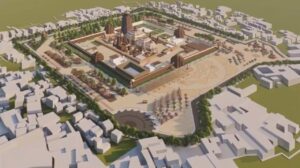Puri Heritage Corridor Project
Context:
The ambitious Puri heritage corridor project of the recent affidavit filed by the Archaeological Survey of India in the Orissa High Court has further intensified the debate around the project.
About:
- Puri Heritage Corridor Project, which was conceived in 2016, was unveiled in December 2019 to transform the town into a worldwide heritage destination.
- For visitors and tourists, the project include redeveloping key areas of the town and the area around the temple.
- In February 2020, the state assembly unanimously passed a resolution to begin the project’s first phase of work, which is anticipated to cost Rs 800 crore.
- The Shree Jagannath Temple Administration (SJTA) then accepted the project’s architectural design plan, which is expected to cost Rs 3,200 crore.
- In total, 22 separate projects will be implemented in stages.

What is the issue?
- The ASI is the curator of the 12th century shrine, which is a centrally protected monument.
- Construction operations inside a 100 metre radius of a monument’s perimeter are prohibited by the Ancient Monuments and Archaeological Sites and Remains (Amendment and Validation) Act.
- Construction can only take place with the National Monuments Authority’s permission (NMA). Under the requirements of the AMSAR Act, NMA, a body under the Union Ministry of Culture, was established for the protection and preservation of monuments and sites through management of the banned and regulated area around centrally protected monuments.
- One of the NMA’s roles is to evaluate granting permits to applicants for construction-related activities in the restricted and regulated areas.
- NMA guidelines suggest that a heritage impact assessment study is a must for developmental work around any monument of archaeological importance with a built-up area of over 5,000 square metre.
- The Jagannath temple is spread over 43,301.36 sq metre.
- On September 4, 2021, the NMA granted the state government a No Objection Certificate (NOC) allowing the construction of a cloakroom, a shelter pavilion, three toilets, an electrical room, and a pavement within the forbidden 75-meter zone for the heritage project.
- The NOC is based on the fact that public amenities do not fall under the AMASR Act’s definition of construction, and that NMA has no objections provided the project is carried out under ASI’s supervision.
- The ASI, on the other hand, has not granted any such NOC.
Source The Hindu




